Chapter 1 Advanced Manufacturing Technology (AMT) 先进制造技术双语教学课件-HTC
- 格式:ppt
- 大小:6.46 MB
- 文档页数:95
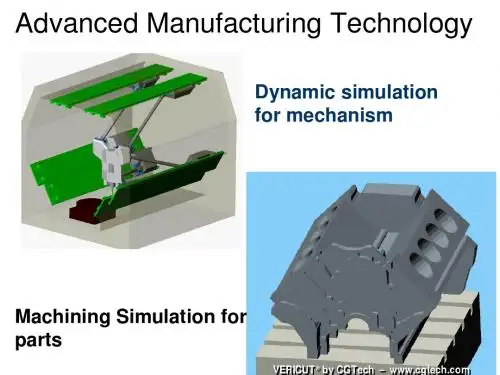
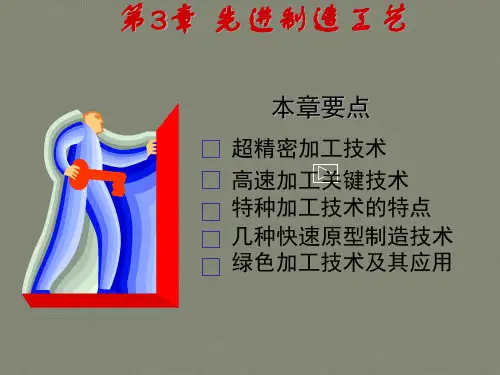
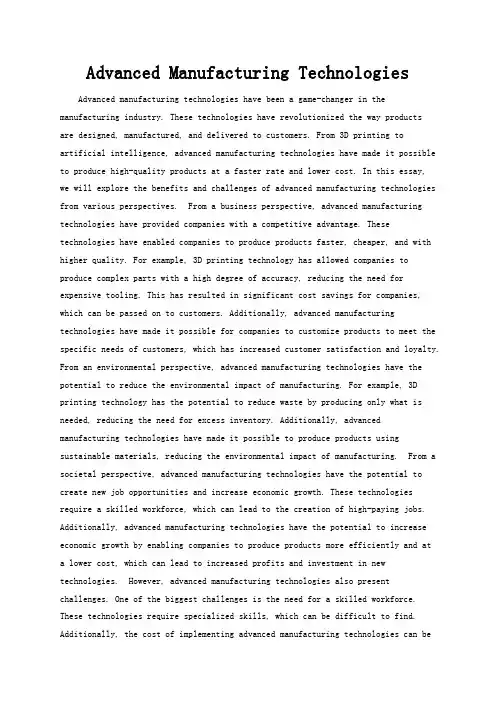
Advanced Manufacturing TechnologiesAdvanced manufacturing technologies have been a game-changer in the manufacturing industry. These technologies have revolutionized the way productsare designed, manufactured, and delivered to customers. From 3D printing toartificial intelligence, advanced manufacturing technologies have made it possible to produce high-quality products at a faster rate and lower cost. In this essay,we will explore the benefits and challenges of advanced manufacturing technologies from various perspectives. From a business perspective, advanced manufacturing technologies have provided companies with a competitive advantage. These technologies have enabled companies to produce products faster, cheaper, and with higher quality. For example, 3D printing technology has allowed companies to produce complex parts with a high degree of accuracy, reducing the need for expensive tooling. This has resulted in significant cost savings for companies, which can be passed on to customers. Additionally, advanced manufacturing technologies have made it possible for companies to customize products to meet the specific needs of customers, which has increased customer satisfaction and loyalty. From an environmental perspective, advanced manufacturing technologies have the potential to reduce the environmental impact of manufacturing. For example, 3D printing technology has the potential to reduce waste by producing only what is needed, reducing the need for excess inventory. Additionally, advanced manufacturing technologies have made it possible to produce products using sustainable materials, reducing the environmental impact of manufacturing. From a societal perspective, advanced manufacturing technologies have the potential to create new job opportunities and increase economic growth. These technologies require a skilled workforce, which can lead to the creation of high-paying jobs. Additionally, advanced manufacturing technologies have the potential to increase economic growth by enabling companies to produce products more efficiently and ata lower cost, which can lead to increased profits and investment in new technologies. However, advanced manufacturing technologies also present challenges. One of the biggest challenges is the need for a skilled workforce. These technologies require specialized skills, which can be difficult to find. Additionally, the cost of implementing advanced manufacturing technologies can behigh, which can be a barrier for smaller companies. Finally, advanced manufacturing technologies can also lead to job displacement, as some tasks previously done by humans can now be automated. In conclusion, advanced manufacturing technologies have the potential to revolutionize the manufacturing industry. From a business perspective, these technologies provide companies with a competitive advantage by enabling them to produce products faster, cheaper, and with higher quality. From an environmental perspective, these technologies have the potential to reduce the environmental impact of manufacturing. From a societal perspective, these technologies have the potential to create new job opportunities and increase economic growth. However, these technologies also present challenges, such as the need for a skilled workforce, the high cost of implementation, and job displacement. Overall, the benefits of advanced manufacturing technologies outweigh the challenges, and companies that embrace these technologies are more likely to succeed in the long run.。

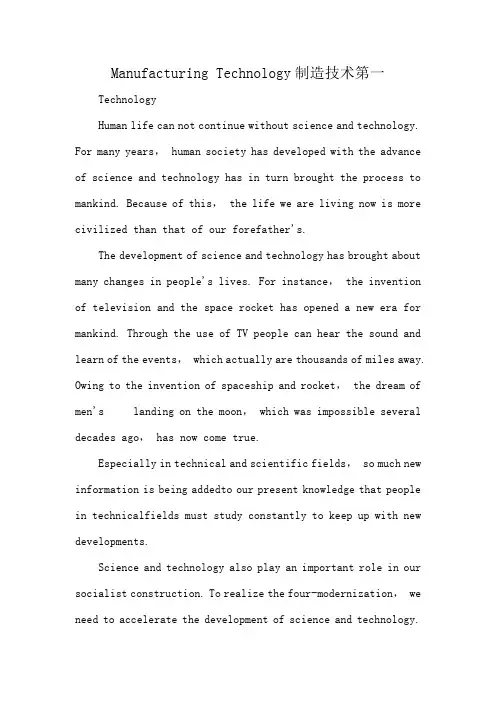
Manufacturing Technology制造技术第一TechnologyHuman life can not continue without science and technology. For many years, human society has developed with the advance of science and technology has in turn brought the process to mankind. Because of this, the life we are living now is more civilized than that of our forefather's.The development of science and technology has brought about many changes in people's lives. For instance, the invention of television and the space rocket has opened a new era for mankind. Through the use of TV people can hear the sound and learn of the events, which actually are thousands of miles away. Owing to the invention of spaceship and rocket, the dream of men's landing on the moon, which was impossible several decades ago, has now come true.Especially in technical and scientific fields, so much new information is being addedto our present knowledge that people in technicalfields must study constantly to keep up with new developments.Science and technology also play an important role in our socialist construction. To realize the four-modernization, we need to accelerate the development of science and technology.It is hard to imagine that the modernization of industry,agriculture and national defense of our country can be realized without the application of modern science and technology. We may say, our socialist construction is just like a skyscraper,while science and technology are its base. Without the base,the skyscraper can't be built.Therefore we should all try our best to contribute, however small, to the development of science and technology so as to provide a more solid base on which we build our country.。
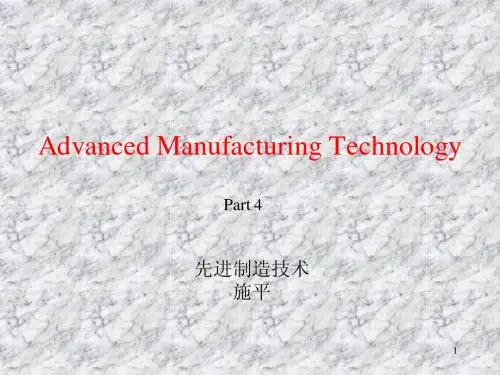
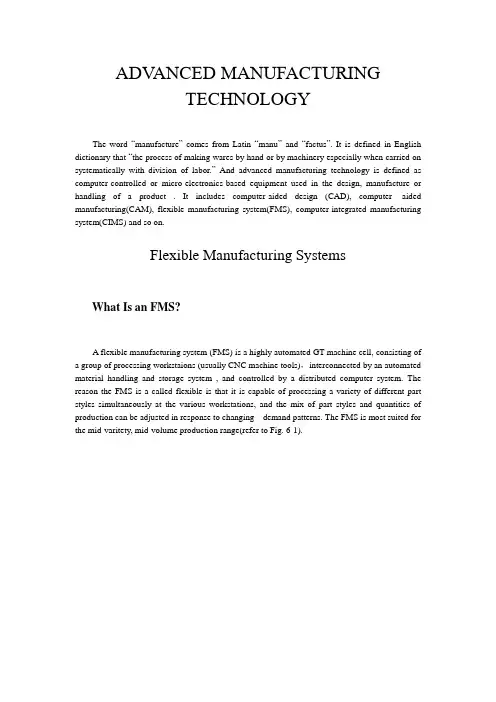
ADV ANCED MANUFACTURINGTECHNOLOGYThe word “manufacture”comes from Latin “manu”and “factus”. It is defined in English dictionary that “the process of making wares by hand or by machinery especially when carried on systematically with division of labor.”And advanced manufacturing technology is defined as computer-controlled or micro-electronics-based equipment used in the design, manufacture or handling of a product . It includes computer-aided design (CAD), computer- aided manufacturing(CAM), flexible manufacturing system(FMS), computer-integrated manufacturing system(CIMS) and so on.Flexible Manufacturing SystemsWhat Is an FMS?A flexible manufacturing system (FMS) is a highly automated GT machine cell, consisting of a group of processing workstaions (usually CNC machine tools),interconnected by an automated material handling and storage system , and controlled by a distributed computer system. The reason the FMS is a called flexible is that it is capable of processing a variety of different part styles simultaneously at the various workstations, and the mix of part styles and quantities of production can be adjusted in response to changing demand patterns. The FMS is most suited for the mid-varitety, mid-volume production range(refer to Fig. 6-1).Fig. 10-1 Automated manufacturing cell withtwo machine tools and robotThe initials FMS are sometimes used to denote the tern flexible system . The machining process is presently the largest application area for FMS technology. However it seems appro- priate to interpret FMS in its broader meaning , allowing for a wide range of possible application beyond machining.An FMS relies on the principles of group technology. No manufacturing system can be completely flexible. There are limits to the range of parts or products that can be made in an FMS. Accordingly, an FMS is designed to produce parts (or products) within a defined range of styles, sizes, and processes. In other words, an FMS is capable of producing a single part family or a limited range of part families.A more appropriate term for an FMS would be flexible automated manufacturing system. The use of the word "automated" would distinguish this type of production technology from other manufacturing systems that are flexible but not automated such as a manned GT machine cell. On the other hand , the word “flexible” would distinguish it from other manufacturing systems that are highly automated but not flexible ,such as a conventional transferline. However, the existing terminology is well established.What Make It Flexible?The issue of manufacturing system flexibility was discussed in previous sections. In that discussion,we identified three capabilities that a manufacturing system must possess to be flexib1e: (1) the ability to identify and distinguish among the different part or product styles processed by the system; (2) quick changeover of operating instructions; and (3)quickchangeover of physical setup. Flexibility is an attribute that applies to both manual and automated systems. In manual systems the human workers are often the enablers of the system's flexibility.To develop the concept of flexibility in an automated manufacturing system, consider a machine cell consisting of two CNC machine tools that are loaded and unloaded by an industrial robot from a parts carousel,perhaps in the arrangement depicted in Fig. 6-1. The cell operates unattended for extended periods of time. Periodically, a worker must unload completed parts from the carousel and replace them with new workparts. By any definition, this is an automated manufacturing cell,but is it a flexible manufacturing cell? One might argue that yes,it is flexible,since the cell consists of CNC machine tools,and CNC machines are flexible because they can be programmed to machine different part configurations. However, if the cell only operates in a batch mode,in which the same part style is produced by both machines in lots of several dozen (or several hundred) units then this does not qualify as flexible manufacturing.To qualify as being flexible, a manufacturing system should satisfy several criteria, the following are four reasonable tests of flexibility in an automated manufacturing system.1. Part variety test. Can the system process different part styles in a nonbatch mode?2. Schedule change test.Can the system readily accept changes in production schedule, and changes in either part mix or production quantities?3. Error recovery test.Can the system recover gracefully from equipment malfunctions and breakdowns,so that production is not completely disrupted?4. New part test.Can new part designs be introduced into the existing product mix with relative ease?If the answer to all of these questions is "yes" for a given manufacturing system, then the system can be considered flexible. The most important criteria are (1) and (2). Criteria (3) and (4) are softer and can be implemented at various levels. In fact, introduction of new part design is not a consideration in some FMSs; such system are designed to produce a part family whose members are all known in advance.If the automated system does not meet at least the first three tests, it should not be classified as an FMS. Getting back to our illustration,the robotic work cell satisfies the criteria if it: (1) can machine different part configurations in a mix rather than in batches; (2) permits changes in production schedule and part mix; (3) is capable of continuing to operate even though one machine experiences a breakdown (e, g,,while repairs are being made on the broken machine, its work is temporarily reassigned to the other machine); and (4) as new part designs are developed, NC part programs are written off-line and then downloaded to the system for execution. This fourth rapability requires that the new part is within the part family intended for the FMS, so that the tooling used by the CNC machines as well as the end effector of the robot are suited to the new part design.Over the years, researchers and practitioners have attempted to define manufacturing flexibility. These attempts arc documented in several of our references. The result of these efforts is the conclusion that flexibility in manufacturing has multiple dimensions; there are various type of flexibility.CAD/CAM/CAPPThroughout the history of our industrial society, many inventions have been patented and whole new technologies have evolved. Perhaps the single development that has impacted manufacturing more quickly and significantly than any previous technology is the digital computer. Computers are being used increasingly for both design and detailing of engineering components in the drawing office.CADComputer-aided design (CAD) is defined as the application of computers and graphics software to aid or enhance the product design from conceptualization to documentation. CAD is most commonly associated with the use of an interactive computer graphics system, referred to as a CAD system. Computer-aided design systems are powerful tools and are used in the mechanical design and geometric modeling of products and components.There are several good reasons for using a CAD system to support the engineering design function:●To increase the productivity●To improve the quality of the design●To uniform design standards●To create a manufacturing data base●To eliminate inaccuracies caused by hand-copying of drawings and inconsistencybetween drawingsComputer aided design (CAD) also can be defined as using computers to aid the engineering design process by means of effectively creating, modifying, or documenting the part’s geometrical modeling. CAD is most commonly associated with the use of an interactive computer graphics system. The object of the engineering design is stored and represented in the form of geometric models. Geometric modeling is concerned with the use of a CAD system to develop a mathematical description of the geometry of an object. The mathematical description is called a model. There are three types of models (wire-frame models, surface models, and solid models), that are commonly used to represent a physical objects. Wire-frame models, also called edge-vertex or stick-figure models, are the simplest method of modeling and are most commonly used to define computer models of parts. Surface models may be constructed using a large variety of surface features. Solid models are recorded in the computer result;it is possible to calculate mass properties of the parts, which is often required for engineering analysis such as finite element methods, kinematics or dynamic studies, and mass or heat transfer for interference checking.Models in CAD also can be classified as being two-dimensional models, two-and-half- dimensional models, or three-dimensional models. A 2-D model represents a flat part and a 3-Dmodel provides representation of a generalized part shape. A 212-D model can be used to represent a part of constant section with no side-wall details. The major advantage of a 212-D model is that it gives a certain amount of 3-D information about a part without the need to create the database of a full 3-D model.After a particular design alternative has been developed, some form of engineering analysis must often be performed as a part of the design process. The analysis may take the form stress-strain calculations, heat transfer analysis, dynamic simulation etc. Some examples of the software typically offered on CAD systems are mass properties and Finite Element Method (FEM) analysis. Mass properties involve the computation of such features of a solid object as its volume, surface area, weight, and center of gravity. FEM analysis is available on most CAD systems to aid in heat transfer, stress-strain analysis, dynamic characteristics, and other engineering computations. Presently, many CAD systems can automatically generate the 2-D or 3-D FEM meshes which are essential to FEM analysis.CAMComputer-aided manufacturing (CAM) is defined as the effective use of computer technology in manufacturing planning and control. CAM is most closely associated with functions in manufacturing engineering, such as process and production planning, machining, scheduling, management, quality control, and numerical control (NC) part programming. Computer-aided design and computer-aided manufacturing are often combined into CAD/CAM systems.This combination allows the transfer of information from the design stage into the stage of planning for the manufacturing of a product, without the need to reenter the data on part geometry manually. The database developed during CAD is stored; then it is processed further, by CAM, into the necessary data and instructions for operating and controlling production machinery, material-handling equipment, and automated testing and inspection for product quality.CAM also can be defined as computer aided preparation manufacturing including decision-making,process and operational planning, software design techniques, and artificial intelligence, and manufacturing with different types of automation (NC machine, NC machine centers, NC machining cells, NC flexible manufacturing systems), and different types of realization (CNC single unit technology, DNC group technology).The CAM covers group technology, manufacturing database, automated and tolerance.When a design has frozen, manufacturing can begin. Computers have an important role to play in many aspects of production. Numerically controlled machine tools need a part program to define the components being made; computer techniques exist to assist, and in some cases virtually automate the generation of part programs. Modern shipbuilding fabricates structures from welded steel plates that are cut from a large steel sheet. Computer-controlled flame cutters are often used for this task and the computer is used to calculate the optimum layout of the components to minimize waste metal. Numerically controlled pipe-bending machines are able to operate directly from part programs generated by pipe-routing software.Printed circuit board assembly can also be improved by computer methods. Quality ismaintained by computer-controlled automatic test equipment that diagnoses faults in a particular board and rejects defective boards from the assembly line. Computers are used extensively to plot the artwork used to etch printed circuit boards and also to produce part programs for NC drilling machines.One of the most important manufacturing function is stock and production control. If the original design is done on a computer, obtaining lists of material requirements is straightforward. Standard computer data processing methods are employed to organize the work flow and order components when required.Rationale for CAD/CAMThe rationale for CAD/CAM is similar to that used to justify any technology-based improvement in manufacturing. It grows out of a need to continually improve productivity, quality and competitiveness. There are also other reasons why a company might make a conversion from manual processes to CAD/CAM:●Increased productivity●Better quality●Better communication●Common database with manufacturing●Reduced prototype construction costs●Faster response to customersCAD/CAM HardwareThe hardware part of a CAD/CAM system consists of the following components:(1) one or more design workstations, (2) digital computer, (3) plotters, printers and other output devices, and (4) storage devices. The relationship among the components is illustrated in fig.10.1. In addition, the CAD/CAM system would have a communication interface to permit transmission of data to and from other computer systems, thus enabling some of the benefits of computer integration.Fig.10.2 Configuration of a Typical CAD/CAM SystemThe workstation is the interface between computer and user in the CAD system. Thedesign of the CAD workstation and its available features have an important influence on the convenience, productivity, and quality of the user’s output. The workstation must include a graphics display terminal and a set of user input devices. CAD/CAM applications require a digital computer with a high-speed control processing unit (CPU). It contains the main memory and logic/arithmetic section for the system. The most widely used secondary storage medium in CAD/CAM is the hard disk, floppy diskette, or a combination of both.The typical I/O devices used in a CAD system are shown in Fig.10.2. Input devices are generally used to transfer information from a human or storage medium to a computer where “CAD functions” are carr ied out. There are two basic approaches to input an existing drawing:model the object on a drawing or digitize the drawing. The standard output device for CAD/CAM is a CRT display. There are two major types of CRT displays: random-scan-line-drawing displays and raster-scan displays. In addition to CRT, there are also plasma panel displays and liquid-crystal displays.Fig.10.3 I/O Devices of a CAD SystemCAD/CAM SoftwareSoftware allows the human user to turn a hardware configuration into a powerful designand manufacturing system. CAD/CAM software falls into two broad categories, 2-D and 3-D, based on the number of dimensions visible in the finished geometry. CAD packages that represent objects in two dimensions are called 2-D software. Early systems were limited to 2-D. This was a serious shortcoming because 2-D representations of 3-D objects is inherently confusing. Equally problem has been the inability of manufacturing personnel to properly read and interpret complicated 2-D representations of objects. 3-D software permits the parts to be viewed with the three-dimensional planes-height, width, and depth-visible. The trend in CAD/CAM is toward 3-D representation of graphic images. Such representations approximate the actual shape andappearance of the object to be produced; therefore, they are easier to read and understand.Applications of CAD/CAMThe emergence of CAD/CAM has had a major impact on manufacturing, by standardizing product development and by reducing design effort, tryout, and prototype work; it has made possible significantly reduced costs and improved productivity.Some typical applications of CAD/CAM are as follows:Programming for NC, CNC, and industrial robots;Design of dies and molds for casting, in which, for example, shrinkage allowances are preprogrammed;Design of tools and fixtures and EDM (electrical-discharge machining) electrodes;Quality control and inspection——for instance, coordinate-measuring machines programmedon a CAD/CAM workstation;Process planning and scheduling.CAPPComputer aided process planning (CAPP) can be defined as the functions which use computers to assist the work of process planners. The levels of assistance depend on the different strategies employed to implement the system. Lower level strategies only use computers for storage and retrieval of the data for the process plans which will be constructed manually by process planners, as well as for supplying the data which will be used in the planner’s new work. In comparison with lower level strategies, higher level strategies use computers to automatically generate process plans for some work pieces of simple geometrical shapes. Sometimes a process planner is required to input the data needed or to modify plans which do not fit specific production requirements well. The highest level strategy, which is the ultimate goal of CAPP, generates process plans by computer, which may replace process planners, when the knowledge and expertise of process planning and working experience have been incorporated into the computer programs. The database in a CAPP system based on the highest level strategy will be directly integrated with conjunctive systems, e.g. CAD and CAM. CAPP has been recognized as playing a key role in CIMS (Computer integrated manufacturing system).More than 20 years have elapsed since the use of computers to assist process planning tasks was first proposed. Tremendous efforts have been made in the development of CAPP systems. For the time being, the research interests for development of CAPP systems are focused on intelligent and integrated process planning systems. For increasing the intelligence of CAPP systems, some new concepts, such as neural networks, fuzzy logic, and machine learning have been explored for the new generation of CAPP systems. For increasing the integrability of CAPP system, feature based design, the roles of features, integrating process planning with scheduling, and integrating process planning with manufacturing resources planning have been focused on. This phenomenon is entitled concurrent or simultaneous engineering.Since a process plan determines the methods, machines, sequences, fixturing, and tools required in the fabrication and assembly of components, it is easy to see that process planning is one of the basic tasks to be performed in manufacturing systems. The task of carrying out the difficult and detailed process plans has traditionally been done by workers with a vast knowledge and understanding of the manufacturing process. Many of these skilled workers, now considered process planners, are either retired or close to retirement, with no qualified young process planners to take their place. An increasing shortage of process planners has been created. With the high pressure of serious competition in the world market, integrated production has been pursued as a way for companies to survive and succeed. Automated process planning systems have been recognized as playing a key role in CIMS. It is for reasons such as these that many companies look for computer aided process systems.。
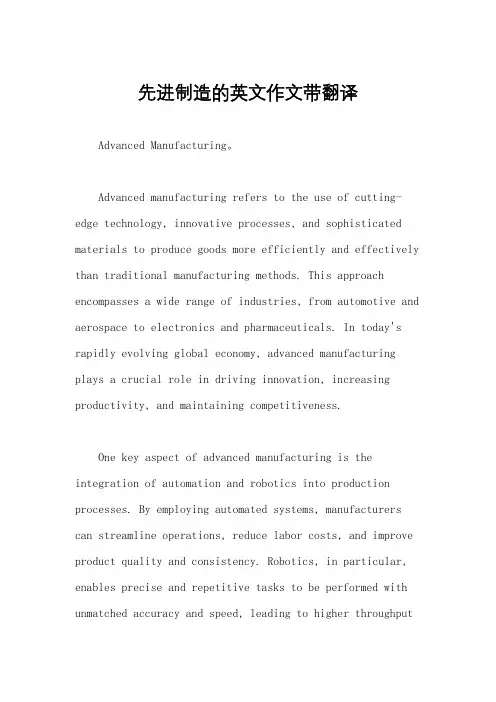
先进制造的英文作文带翻译Advanced Manufacturing。
Advanced manufacturing refers to the use of cutting-edge technology, innovative processes, and sophisticated materials to produce goods more efficiently and effectively than traditional manufacturing methods. This approach encompasses a wide range of industries, from automotive and aerospace to electronics and pharmaceuticals. In today's rapidly evolving global economy, advanced manufacturing plays a crucial role in driving innovation, increasing productivity, and maintaining competitiveness.One key aspect of advanced manufacturing is the integration of automation and robotics into production processes. By employing automated systems, manufacturers can streamline operations, reduce labor costs, and improve product quality and consistency. Robotics, in particular, enables precise and repetitive tasks to be performed with unmatched accuracy and speed, leading to higher throughputand lower error rates.Furthermore, advanced manufacturing techniques often involve additive manufacturing, commonly known as 3D printing. This revolutionary technology enables the creation of complex components and structures layer by layer, using a variety of materials ranging from plastics to metals. Additive manufacturing offers significant advantages over traditional subtractive methods, such as CNC machining, including reduced material waste, faster prototyping, and greater design flexibility.Another key enabler of advanced manufacturing is the Internet of Things (IoT), which refers to the network of interconnected devices and sensors that collect and exchange data in real-time. By harnessing the power of IoT, manufacturers can monitor equipment performance, optimize production processes, and predict maintenance needs, thereby minimizing downtime and maximizing efficiency.Moreover, advanced manufacturing relies heavily on advanced materials with unique properties andcharacteristics. These materials, such as carbon fiber composites and high-strength alloys, offer superiorstrength-to-weight ratios, corrosion resistance, andthermal conductivity, making them ideal for demanding applications in aerospace, defense, and beyond.In addition to technological advancements, advanced manufacturing also requires a skilled workforce capable of operating and maintaining complex machinery, analyzing data, and implementing continuous improvement initiatives. As such, education and training programs play a vital role in preparing the next generation of manufacturingprofessionals for the challenges and opportunities of the future.In conclusion, advanced manufacturing represents a paradigm shift in the way goods are produced, leveraging technology, innovation, and talent to drive efficiency, quality, and competitiveness. By embracing advanced manufacturing principles and practices, companies can stay ahead of the curve and thrive in today's dynamic and ever-changing marketplace.先进制造。
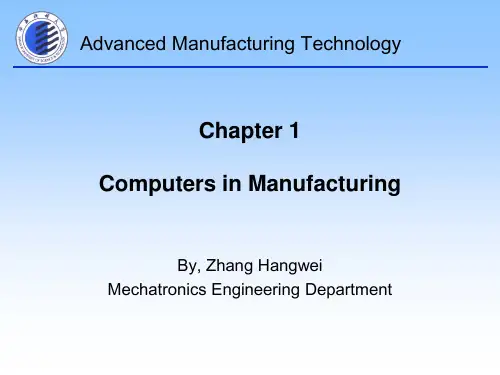
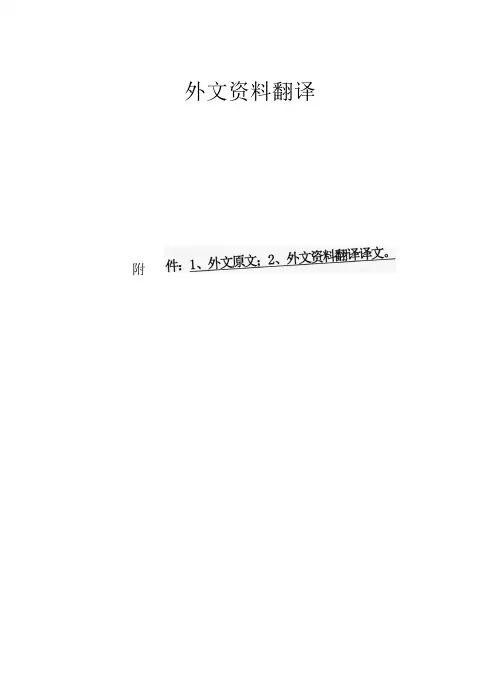
外文资料翻译附1、外文原文(复印件)Advanced Manufacturing Techndogylimitations on acceptable feed rates-determined by the ability of the cutting t∞l to withstandincreased cutting loads without fracture.Increasing radial cutting depths also could increase removal rates, although cutting depth is often determined by the amount of stock removal required. As in the case of increased feedrates, IOol life decreased with increased depth of cut. As expected t a tradeoff exists between t∞llife and removal rate.generated in every Inetal removal process: tangential There are three forforce, generated by the part rotation; radial force, generated by the resistance of the workpiecematerial to depth of cut; and, lastly, longitudinal force, generated by the feed rate applied. Theseforces are 30% to 80% greater than in “soft" machining processes. For example f when comparingpreheat-treated to heat-treated steel with a hardness of 62 HRC, the longitudinal force increasesfrom 30% to 50% ∙ Thetangential force increases 30% to 40% f and the radial force increases from 70% to 1CK)% ∙Therefore, the machine tool must be able to handle the increased cutting forces t especially in theradial direction.Cutting c∞lant can influence the generation of white layer. Because white layer is thought to occur as the result of a phase transformation on the surface, cutting c∞1ant might helpeliminate thermal damage by keeping the workpiece surface c∞L So<ne reports say cuttingc∞lant eliminates white layer, but other studies show c∞!ant having no effect. T∞l condition isalso believed to be an important factor, with new t∞ls producing undamaged surfaces, whilewhite layer increases with increasing t∞l wear.If hard turning is to replace finish grinding operations, it must be capable of ProdUCing surface finishes comparable to those generated by grinding. Unlike grinding, where surface finishis deteπnined by the size, shape, hardness> and distribution of abrasive grains in the grindin gwheel, hard-turned surfaces are nominally defined by the geometry of the cutting process,primarily by the cutting t∞Γs feed rate and nose radius.For grinding cylindrical applications, both the wheel and the woriφiece must rotate.Moreover, the wheel rotates rapidly while the workpiece rotates slowly. If the rotating membersare imperfectly concentric, the combination of imperfections and ∏)lational speed differentialproduces lobing. A geometric OUl-Of-round pattern on the workpiece is produced t which canaffect the end-product performance. With hard turning t on the other hand l either the workpieceor cutting t∞l is rotated, not both.Z7∏5Therefbre, the machined surface will be as accurate as the machine tool spindle and the longitu dinal direction Ot the machine t∞l relative to the center line of the machine.Another disadvantage with grinding is the generation of tremendous surface heat at the point of contact between the grinding wheel and the workpiece. Even when flood cwlant is properly applied, workpiece surface stress risers and heat checks can occur, which can lead to premature failure of the ground part in service. With hard turning, less heat is generated t and if properly applied, the heat that is generated will be carried away with the brittle material removed. Thus, the finished parts are produced without stress risers or heat checks.Another major advantage of HFM is that conventional turning machines can be used with workpieces as hard as 65 HRC using commercially available ceramic inserts. Savings occur in two areas, processing and capital investment. In processing, the machining t setup, and t∞l changing time are significantly reduced. Grinding wheel changing, on the other hand, is time-consuming. Guards must be removed, along with the spindle locking nuts, the worn wheel must be changed, and the new wheel balanced and dressed. Wheel changing can take as much as IOO times longer than changing ceramic inserts, which require only simple indexing or replacement in the holder.Equipment also is less expensive. A turning machine costs significantly less than a production grinder to do comparable work. As already mentioned, setup is easier and quicker. Turning machines also are simpler in ∞nstruction-there are no reciprocating slides to wear, maintain, or replace-for easier maintenance. However, the strength and rigidity of every component in the machine must be adequate to handle the additional cutting forces.3.7.2 Hard MillingOne machining advancement that has taken hold over the past few years is hard milling. Typically mold and die makers perform hard milling to cut P∙20, H-13 and other tool steels.These materials range in hardness from 45 to 64 HRC and are traditiona]ly electrical discharge machined. But new technologies make hard milling a viable alternative. Successful hard milling requires several components to ∞me together一the machine tool, t∞lholders f cutting IoolSg CAD/CAM system and pr how.S u know-… -------------------- Advanced MamArturing Technology Ho VV —1> Machine FactorsThe machine t∞l is the most significant component. The m aspect of the machine tool is that it must be designed for hard milling and have the samecharacteristics found in a high-speed machining center. The machine t s base ∞nstιυction andindividual components, such as the drive train, spindle and CNC, must be capable of handling thedemands of hard milling.The base ∞nstruction must be extremely rigid and have a high degree of damping abilities.These characteristics are found in machine tools with bases ∞nstructed from polymer concrete.These machines typically have six to 10 times the damping characteristics of machines with castiron bases. Additionally, polymer ∞ncrete has excellent mechanical and theππal characteristics.The machine t∞Γs drive train should in∞rporate digital drive technology for optimalacceleration and de celeration. This technology allows the CNC to perfbπn a high degree ofcontouring accuracy and gives it excellent dynamics capabilities.One of the most overlooked components is the spindle. The spindle must be able to providea great deal of flexibility, offering high torque at low spindle speeds and maximum power for alarge range of spindle speeds. An ideal spindle t s speed ranges from 100 rpm to 20f 000 rpm orhigher, depending on the application. Hybridceramic bearings in the construction of the spindle increase spindle Stiffil andtemperature stability. Figure 3.14 shows a 5-axis milling machine designed forhard milling, which has a similar requirements as high-speed machining.Figure 3.14 Mikron 1S HSM 5-axis machine.fundamental,accuracyOne of the main ∞ntributors to successful hard milling is the cutting tool. Fbr roughing hardened materials9 end mills with four or more flutes arc recommended. These provide small chip loads while having the capability to cut at higher feed rates.The cutting took should be short with short flute lengths and have a helix angle of approximately 300. A 30o helix has proven to be optimal for chip flow and dispersal of heat.The carbide substrate should also be ∞nsidered. Only caιbide t∞ls with fine or ultra-fine grain sizes9about 0.5μm to0.6 μm , should be used. These tools provide increased edge strength and reduce built-up edge.For milling larger hardened cavities and cores, cutting t∞ls with inserts should be considered. Carbide inserts are less expensive than solid-caΛide end-mills, and by indexing the insert, tool life can be extended. However, these t∞ls are typically not designed for high spindle speeds. There is also a significant safety risk if improperly handled.Hard milling puts a great amount of stress on the cutting tool from high heat and abrasive wear. To help overcome these stresses, coated cutting t∞Js must be used. Coatings offer a protective layer on the IoOI, substantially increasing t∞l life.Coating selection should be made based on individual properties. Titanium-based coatings, such as TiCN and TiAlN, are the most common for hard milling. The wear resistance, or its Iianlness l is the most important property of TiCN, while TiAlN resists heat and oxidation better. The t∞lmaker may further enhance its coatings by offering unique multilayer blends.Flood c∞lant is not commonly used in hard millin g. Hard milling often generates tremendous amount of heat, which is transferred into the chips and causes the c∞lant to vaporize as it hits the hot chips. The use of ∞olant can also create thermal instability with the cutting t∞l.Compressed air is used to help displace chips during cutting› Additionally, a ∞mbination of oil and mist is often selected. Oil helps reduce friction, thereby increasing tool life and improving surface finish. When using oil and mist, an extraction unit should be integrated into the machine t∞l to help remove the oil from the air.2.CAD/CAM AnalysisThe CAD/CAM system is another important component. CAD/CAM systems have gready advanced over the years, and now provide a variety of advanced featuresAdvanced Manufacturing TechncJogy118 ∖∖and capabilities. However t not all systems are created equal and there are still many (hat do not have the capabilities to create t∞l paths for hard nulling .Although no CAD/CAM system is designed exclusively for hard milling, many of the systems that offer HSMing capabilities have the same strategies for hard milling because the two are related. When hard milling t strategies that keep the cutting tool in motion should be used. This ensures the t∞l is ∞ntinuously cutting with a constant chip load, which is one of the more desirable conditions to maintain when hard milling.Before tool paths can be applied, a complete analysis of the part must be performed. Not all parts are suitable for hard milling. The specific areas to be machined should be clearly identified, determining the smallest internal radius and largest working depth. A tool with a 4:1 length-to-diameter ratio commonly does not pose any problems.Problems arise when the ratio grows. When ratios are excessive t hard milling experience plays an important role in deteπnining how successful one is. Hard milling with small diameter cutting tools are possible as long as care is taken to maintain a ∞nstant chip load and machine at minimal LXXs.If a CAD/CAM system does not have the t∞ls to verify or simulate the NC code directly, there are numerous software packages on the market that can.Finally, proper know-how is vital to successful hard milling. AD of the necessary components are of no use without knowledge of the processing procedures ∙ Successful hard milling is based on specific know-how, advanced knowledge HSMing t proper choice of cutting t∞ls and clamping systems, and using a HSM- capable CAD/CAM system.A clear understanding of all the components provides better awareness of what is needed to be successful at hard milling.3.Precision MachiningPrecision machining is any process using a cutting tool, whether turning, milling, or grinding, which forms a precise dimension, form, and finish of surface. The accuracy held must be 10 μm or less. Any operation resulting in less accuracy is generally ∞nsιdcred ∞nventional machining.Compared to standard machining of traditional materials (steel, Al) f successful precision machining of hard materials is more sensitive to parameters such as machine IoOl accuracy, stiffness, toolholder design t cutting t∞l material and geometιy,fixtυring, c∞)ant presentation, and machining technique.The properties that make hard materials attractive for commercial use also make them extremely difficult to machine to the tolerances required by advanced applications.Obtaining tighter tolerances on hard materials is a challenge that must be met if manufacturers are to achieve the improved performance; it f s also where the future of manufacturing lies.A major factor that influences the production of close-tolerance parts from hard materials is the machine tool itself and its parameters, including inherent repeatability, accuracy, stiffness, and the sm∞thness or uniformity of travel t spindle speed, thermal stability, machine protection f control capabilities, etc.Virtually any machine t∞l Can produce some close-tolerance parts if the feed rate is reduced and the cutting t∞I changed frequently. To SUCCeSSftIIIy produce precision components to meet market demands, however, the machining operation must be cost-effective, as well as accurate and repeatable.A key design factor in machine t∞ls is the rigidity or stiffness of the cutting t∞l to the workpiece. Obviously, components and subassemblies must also have high stiffness. Machine stiffness is a major contributing factor to overall machine accuracy and performance. Stiffness is measured by the deflection of an element of the machine when it's subjected to a load.Machine accuracy is another critical design parameter. To have the confidence to cut high-precision parts on a production basis, ifs necessary that the user know the 3-D accuracy of the machine t∞l.The same criteria apply to t∞lholders. They too must provide precision, rigidity f and repeatability to produce close-tolerance parts, and to do so they must be kinematically correct.Cutting tools are another element that ProdUCe a major effect on the production of precision parts from hard materials. Parameters to be considered are: material, design, fabrication t tolerance, cost, and availability.Tool life is an economic issue that must be considered when machining precision parts from hard materials. While it may perfoπn well, a tool that you must change after every IOO mm of cut length is nυ( an economical so lution to machining these materials. T∞l life depends UPon the materia] to be machined and the process.Workholding is another key element. Material considerations are important.2、外文资料翻译译文先进制造技术尽管裁断的深度是由材料去除率的总额决定的,增加径向的裁断深度同样能够增加磨损率。
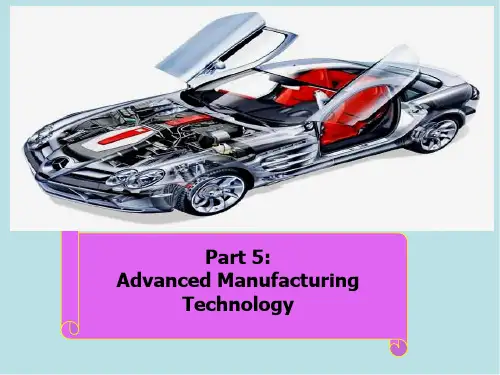
先进制造技术英语作文Advanced manufacturing technology is a hot topic in today's world. It's not just about machines and robots anymore; it's about efficiency, precision, and innovation.Imagine a factory floor where robots work side by side with humans, each specialized in their own tasks. The robots handle the heavy lifting and repetitive jobs, while the humans oversee and make strategic decisions. It's a true collaboration of man and machine.One of the coolest things about advanced manufacturing is how it's making customization possible at a large scale. Whether it's a pair of shoes or a car, customers can now get exactly what they want, down to the smallest detail.It's like having a personal tailor or designer for every product you buy.And the speed! With 3D printing and other cutting-edge technologies, products can be made in a fraction of thetime it took before. This means faster turnaround, less waste, and more satisfied customers.But it's not just about speed and customization. Advanced manufacturing is also about sustainability. New materials and processes are being developed that are lighter, stronger, and more environmentally friendly. We're moving towards a future where production doesn't.。
AdvancedManufacturingTechnology课件翻译Advanced Manufacturing Technology先进制造技术Why we learn?我们为什么学习?Knowledge explosion: too much to be translated知识爆炸:太多的翻译Latest technology: direct access and misunderstanding avoided最新技术:直接访问和误解,避免Communication platform: terminologies in relevant fields沟通平台:在相关领域的术语Academic exchange学术交流Globalization need: competitiveness, better opportunities全球化需要:竞争力,更好的机会Advanced Manufacturing Technology先进制造技术Why in English?为什么在英国?international communication tool国际沟通工具Most latest advancements in science & technology are published in English最新进展,科技发表在英国Advanced Manufacturing Technology先进制造技术Can I learn?我能学到什么?An international language, not just for English-speaking people一种国际语言,不仅为讲英语的人You can‘t communicate internationally with your excellent native tongue, yet you can do it with ?poor‘ English 你不能沟通你的母语,你还可以用―可怜‖的英文Mistakes are normal, everybody makes, including native English-tongued people错误是正常的,每个人,包括土著english-tongued人Advanced Manufacturing Technology先进制造技术What we learn?我们学到了什么?Get acquainted to: relevant concepts and terminologies; overall knowledge about AMT认识到:相关的概念和术语;整体知识系统Proficiency in expressing and exchanging ideas在表达和交流能力Contents内容1. Introduction to AMT1。
Advanced Manufacturing Techniques Advanced manufacturing techniques have revolutionized the way products are designed, produced, and distributed. These techniques encompass a wide range of technologies and processes, including additive manufacturing, automation, robotics, and advanced materials. They have the potential to significantly improve productivity, reduce costs, and enhance product quality. However, they alsopresent challenges and implications for the workforce, the environment, and the global economy. From a technological perspective, advanced manufacturing techniques offer numerous benefits. Additive manufacturing, also known as 3D printing, allows for the production of complex geometries and customized products with minimal material waste. Automation and robotics enable high-speed and high-precision manufacturing processes, leading to increased efficiency and consistency. Advanced materials, such as composites and nanomaterials, offer superior mechanical, thermal, and electrical properties, expanding the possibilities for product design and performance. These technologies have the potential to drive innovation across industries, from aerospace and automotive to healthcare and consumer goods. However, the widespread adoption of advanced manufacturing techniques also raises concerns about their impact on the workforce. Automationand robotics have the potential to replace human workers in repetitive and labor-intensive tasks, leading to job displacement and skill gaps. This trend could exacerbate income inequality and social instability, particularly in regions where manufacturing jobs are a significant source of employment. At the same time, advanced manufacturing requires a highly skilled workforce to operate and maintain the technology, creating a demand for workers with expertise in engineering, programming, and data analysis. Moreover, the environmental implications of advanced manufacturing techniques cannot be overlooked. While these technologies offer opportunities for resource efficiency and waste reduction, they also pose challenges in terms of energy consumption, emissions, and waste management. Additive manufacturing, for example, requires significant energy input,particularly for metal and polymer 3D printing processes. The use of advanced materials, such as carbon fiber composites, raises concerns about thesustainability of raw material sourcing and end-of-life disposal. As the globalmanufacturing industry continues to grow, it is essential to consider the environmental impact of advanced manufacturing techniques and strive for sustainable practices. From a global economic perspective, advanced manufacturing techniques have the potential to reshape supply chains and trade patterns. Additive manufacturing, in particular, has the capacity to decentralize production and enable localized manufacturing, reducing the reliance on long-distance transportation and inventory storage. This shift could lead to a more distributed and resilient manufacturing ecosystem, with implications for global trade dynamics and geopolitical relationships. At the same time, the adoption of advanced manufacturing techniques requires significant capital investment and technological infrastructure, which may pose barriers for developing economies looking to participate in the global manufacturing landscape. In conclusion, advanced manufacturing techniques offer tremendous potential for technological advancement, economic growth, and environmental sustainability. However, their widespread adoption also presents challenges and implications for the workforce, the environment, and the global economy. As these technologies continue to evolve, it is essential to consider their broader impact and work towards inclusive and sustainable practices that benefit society as a whole.。
第一章测试1.( ) is the most critical content of “convergence of Two Industries”. It is notonly the typical business form and model of “convergence of Two Industries”, but also the basic direction and main support of “convergence of TwoIndustries”.A:Accelerate the innovative application of the industrial InternetB:Promote flexible customizationC:Develop industrial culture, tourism and other new forms and models ofbusinessD:Promote the construction of smart factories答案:A2.The main line of “Made in China 2025” is ( ), the main direction of which is topromote intelligent manufacturing, and “Internet +” is an important path toachieve it.A:Construction of smart factoriesB:Network infrastructure constructionC:Deep integration of informatization and industrializationD:Development of digital intelligent technology答案:C3.Maturity is a set of ( ) that refinedly describes the development of one thing,usually as a limited number of levels of maturity, each of which has a cleardefinition, corresponding criteria, and the conditions necessary to achieve it.A:Investment methodologyB:Implementation methodologyC:Management methodologyD:Productivity methodology答案:C4.Introduce the connotation of advanced manufacturing enterprise.答案:5.What is the significance of the transformation of manufacturingintelligentization to China?答案:6.The relationship between “One Belt and One Road” national policy and thedevelopment of advanced manufacturing industry in China答案:第二章测试1.The realization of digital production begins with ( ).A:Digital workshopB:Smart factoryC:Intelligent production unitD:Intelligent production line答案:C2.The six neighborhoods of intelligent manufacturing collaborative platformare: collaborative ____, collaborative ____, collaborative ____, collaborative ____,collaborative ____, and collaborative ____.答案:3.The system level in the intelligent manufacturing standardization referencemodel includes ( ).A:the enterprise layerB:control layerC:layers togetherD:equipment layerE:workshop layer答案:ABCDE4.Product life cycle management (PLM) and supply chain management system(SCM) belong to the collaboration layer and the factory layer respectively.()A:对B:错答案:B5.Intelligent manufacturing equipment includes not only the equipment itself,but also the software system embedded in the equipment and the supportingfacilities cooperating with it.A:错B:对答案:B第三章测试1.Resource elements include physical entities such as design and constructiondrawings, product process documents, raw materials, hardware andsoftware manufacturing ____, production workshops and factories, as well as____ such as electricity and gas. Whether the enterprise has plannedintelligent manufacturing ____ and optimized the ____ structure.In addition,____ is also a component of resources. In the human-machine collaborativeintelligent manufacturing environment, the requirements for employees aregetting higher and higher.答案:2.The architecture of intelligent manufacturing system is constructed throughthe three dimensions ( )A:Intelligent functionsB:System levelC:System integrationD:Life cycle答案:ABC3.Design is through the process of product and process planning, design,reasoning verification and simulation optimization to form the realization ofdesign requirements.()A:错B:对答案:B4.What are the classification and characteristics of product design in intelligentmanufacturing capability maturity?答案:5.what are the level classification and characteristics of procurement inintelligent manufacturing capability maturity?答案:6.What is the position of the industrial Internet in the intelligentmanufacturing system architecture?答案:7.What are the key difficulties in achieving equipment interconnection inintelligent manufacturing?答案:第四章测试1.In the context of intelligent manufacturing, production is the integration of____ and ____ to control the five production factors of human, machine,material, method and environment, so as to realize the intelligent scheduling and adjustment and optimization of the whole production process fromfront-end procurement, production planning management to back-endwarehousing and logistics.答案:2.3D digital model is the foundation of intelligent manufacturing.()A:对B:错答案:B3.There are three typical ways of lean logistics, namely, subsequentintroduction, subsequent construction and Set of Parts Supply (SPS).()A:对B:错答案:B4.The product life cycle includes ( )A:RecessionB:infancyC:maturityD:growth答案:ABCD5.The characteristics of the emerging industry of collaborative manufacturinginclude ( )答案:AC6.what is the role of personalization in emerging formats?答案:第五章测试1.At present, the bottleneck of data in China is ( ).A:Dumb terminals aboundB:Data closure caused by multiple protocolsC:The supply side failed to connect effectivelyD:select other three all答案:D2.In what aspects do you think intelligent manufacturing is intelligentized?答案:3.Advanced Japanese enterprises such as Toyota realize intelligentmanufacturing through the path ().A:Modularization – Standardization – Automation – IntelligenceB:Standardization - automation - modularization - intelligenceC:Automation - Modularization - Standardization - IntelligenceD:Automation - Standardization - Modularization - Intelligence答案:A4.Lean production was originally designed to meet the personalized needs ofmultiple varieties and small batches. Its goal is to enhance the marketadaptability and rapid delivery ability of enterprises, while reducingproduction costs. Its two pillars are ().A:Just-in-time (JIT)B:Andon technologyC:Jidoka (自働化)D:One piece flow答案:AC5. A factory produces some parts. In general, a box of parts in themanufacturing cycle requires 0.02 Days of processing time and 0.08 days of material processing, waiting time and Kanban recovery time. There are 22 parts per box, and the daily requirement of parts is 2000. Considering theuncertainty of demand, the safety inventory is 10% of the demand. If thekanban is shipped once a day and brought back to the last kanban withoutdelay, calculate the number of kanbans required. the number is ().A:10B:40C:30D:20答案:A第六章测试1.The decentralized service model has the following advantages ( ).A:Speed up calculation and reduce data delayB:The nodes interact with each other for higher efficiencyC:Securer dataD:There is no central point that can cause the whole system to fail, so it will be more stable答案:ABCD2.What are the emerging technology developments that could bring about hugegrowth in smart manufacturing?答案:。